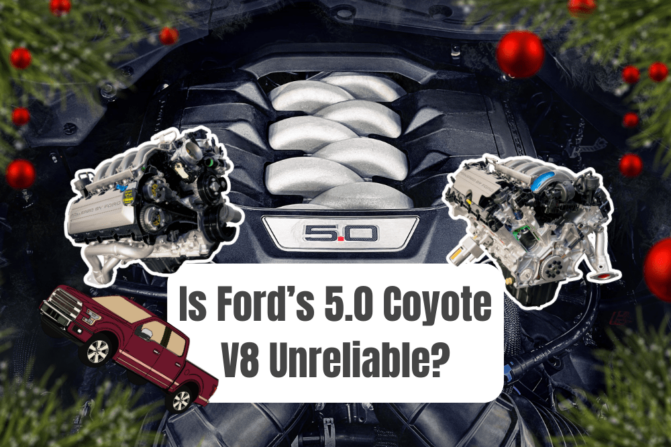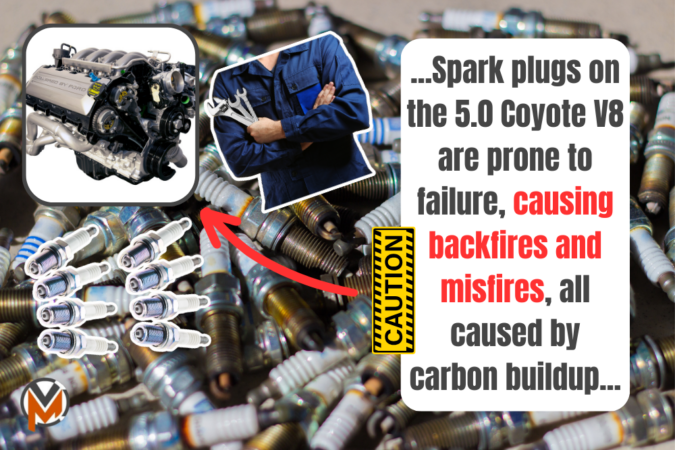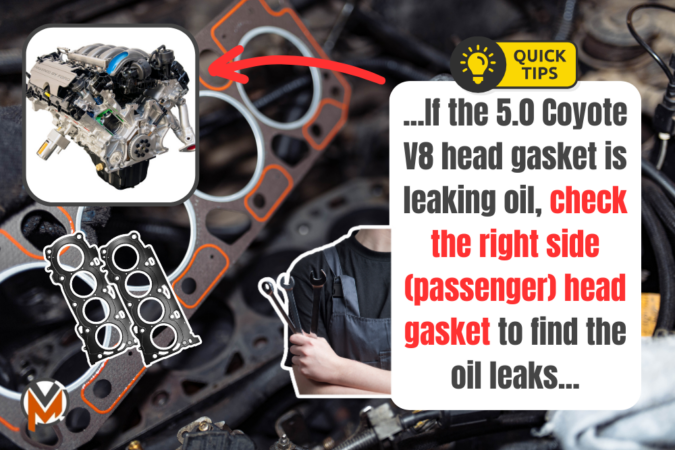The Ford F150 and its 5.0-liter Coyote V8 engine has been a fan-favorite for its immense power and V8 growl, but it’s not without its fair share of problems. Owners have reported problems such as timing chain rattles, spark plug failures, coolant leaks, and throttle body malfunctions. Some are minor, but others, like head gasket replacements, can cost upward of $2,600.
Moreover, we’ve also read reports from owners that mentioned other Ford F150 5.0 Coyote V8 engine problems, such as rattling noises, rough running, oil leaks, random stalling, and even engine knocks. So, with that out of the way, let’s break down the most common problems with Ford’s F150 5.0 Coyote V8 engine, and how you could fix them:
Common Ford F150 5.0 Engine Problems and Fixes
For literally decades, the Ford F150 has crowned itself the king of pickup trucks. To cater to as wide of an audience as possible, the F150 came with numerous engine options, including one of its most iconic pairings, the 5.0-liter Coyote V8. Nonetheless, while many love the rawness of a good ol’ V8 under the hood, the Ford F150 and its 5.0 V8 engine are plagued with problems.
While it’s no lemon, Ford’s 5.0 Coyote V8 is known to suffer problems such as rattling noises and rough running, as well as faulty spark plugs. Moreover, these are compounded by other faults like coolant leaks, head gasket oil leaks, throttle body issues, stalling, and engine knocking… Among others. However, are these problems really that bad?
To get a better idea of how reliable (or, unreliable) the Ford F150 5.0 engine is with all its problems, here are some of the most common issues you might encounter:
Ford F150 5.0 Engine Problems #1. Rattling Noises From The Timing Chain
No one wants to hear their engines make a weird noise, as it always leads to an expensive repair bill. For some unlucky F150 owners, this was the reality. The 5.0 V8 engine in the Ford F150 affected by this problem made scratching, ticking, and rattling noises as the engine got up to operating temperature. You might also notice poor or reduced engine performance.
If these noises go on for a prolonged period of time, these issues can end up causing the engine to file out of time by loosening the tension on the timing chain. To fix this problem, almost all of the timing chain assembly has to be disassembled. Expect a repair bill of around $2,000 to get that work done. You could DIY this repair to save money, but it’ll be tough.
Ford F150 5.0 Engine Problems #2. Rough Running Due To MAF Sensor
Due to an issue with the Mass Air-Flow sensor (MAF), the F150’s 5.0 engine can start to run rough once the vehicle reaches the 100,000-mile mark. The sensor failing due to it getting dirty or accumulation of dirt is the main cause of this issue. In addition to rough running, it also tends to backfire, misfire, shake when idling, and hesitate under acceleration.
To remedy the rough-running engine, there are two possible solutions. The first one is to clean the MAF sensor using an electronic cleaner (you can get the cleaner for just $10). The other, more expensive option is to replace the sensor entirely (if the first option doesn’t work). You can either pay a shop around $165 to $250 to do it or do it at home for around $100.
Ford F150 5.0 Engine Problems #3. Misfires & Backfires From Bad Spark Plugs
Bad spark plugs are behind some of the most widespread Ford F150 5.0 Coyote V8 engine problems. In fact, these are the main culprits of the engine misfires and backfires encountered by a majority of F150 owners. Additionally, these faulty spark plugs also cause the engine to falter when accelerating, in addition to a noticeable reduction in fuel efficiency.
A part of the underlying reason why these spark plugs fail often is due to the build-up of carbon deposits on the spark plug electrodes. Fixing this is as easy as replacing the spark plugs, which often goes for $30 to $60 for a new set of quality spark plugs. If you’re getting a shop to replace it for you instead, it ought to cost you $100 to $200, including labor costs.
Ford F150 5.0 Engine Problems #4. Faulty Connector Causing Coolant Leaks
Another common 5.0 Coyote V8 engine problem plaguing thousands of F150 pickups is coolant leaks. The source of these leaks has been identified as a plastic “T” connector. This connector makes use of an O-ring paired with a threaded connection to form a seal. The connection fails over time, leading to a coolant leak. Replacing the O-ring temporarily fixes the issue.
However, you’ll have to pay around $250 to get the leak permanently fixed. On the other hand, you’ll only have to spend around $60 for a new connector if you plan to replace it by yourself. Otherwise, it’s easy to notice coolant leaks; just watch out for visible puddles under your truck. Or, you’ll also notice low coolant levels and an overheating engine.
Ford F150 5.0 Engine Problems #5. Head Gasket Failures & Oil Leaks
Early versions of the 5.0 Coyote V8 suffered from an issue where oil leaked out from the head gasket. The issue was traced to a design defect, which was corrected in later versions by updating the head gaskets, valve covers, front gaskets, and O-rings. Specifically, motor oil would leak out from the right side head gasket, which risks leaking into the starter motor.
Head gasket oil leaks are an issue that should be addressed quickly, as leaving the oil leaks unfixed can lead to permanent head gasket damage. Sealing off the affected area using an engine block sealant is the most cost-effective fix. A block seal can be bought and applied for a cost of around $35. However, this is only a temporary solution and is not sustainable at all.
Installing an updated head gasket is the only permanent fix for the oil leaks. As you might have guessed, this is not a cheap repair. A head gasket replacement on a 5.0 Coyote engine costs in the ballpark of $2,250 to $2,600, including labor charges. You’ll usually notice these oil leaks right away… Either the smell of burning oil or traces of oil on adjacent components.
Ford F150 5.0 Engine Problems #6. Electronic Throttle Body Goes Bad
The 5.0 Coyote V8 engine uses an electronic throttle body to control the amount of air entering the engine. This component can become faulty, and it’s fairly prevalent on the Ford F150. On most occasions, the issue can be fixed by simply reprogramming the ECU. But, there have been situations where the entire throttle body had to be replaced with a brand-new one.
You’ll notice early signs of failure, such as irregular idling, engine stalling, reduced performance, and throttle delays. In some cases, you could fix it permanently with a throttle body cleaner (for $10 to $15). Otherwise, if that doesn’t work, you’ll need to consider getting a replacement electronic throttle body for anywhere from $400 to $700.
Ford F150 5.0 Engine Problems #7. Constant Stalling From Faulty EGR Valve
Engine stalls are a relatively common complaint among F150 owners and those that have a 5.0 Coyote V8. This can happen either when the vehicle is idling or under acceleration. At times, you may even experience the engine shutting down entirely while you’re driving. A faulty exhaust gas recirculation (EGR) valve is the most likely cause of these engine stalls.
Aside from the EGR valve, which is the most common point of failure, there could be other reasons behind it, too. This could include a clogged fuel injector or blocked fuel filter, as well as faulty ignition coils or spark plugs. Otherwise, if your F150’s EGR valve is indeed the actual cause, you’ll likely need a replacement unit. This should cost you $150 to $300.
Preventative Maintenance Tips
As we’ve seen thus far, the Ford F150 and its 5.0 Coyote V8 engine are prone to many problems, despite an otherwise solid reputation for durability and being long-lasting. Luckily, you can do quite a bit to minimize many of the problems that we mentioned earlier, or even avoid them entirely, all through regular maintenance and taking great care of your engine.
Here are some of our top preventative maintenance tips to help keep your engine running smoothly for years to come:
1. Regular MAF Sensor Cleaning
Your Ford F150’s Mass Airflow (MAF) sensor plays a crucial role in optimizing engine performance by measuring the air entering the engine. A dirty MAF sensor can cause rough running, misfires, and hesitation under acceleration.
To ensure that this won’t happen to you, make sure to clean the MAF sensor every 15,000 to 30,000 miles. You could do this using a dedicated MAF sensor cleaner ($10 to $15). Avoid using standard carburetor cleaners or brake cleaners, as they could potentially damage the MAF sensor.
2. Timely Spark Plug Replacement
Equally, worn-out spark plugs can cause misfires, backfires, poor fuel economy, and sluggish acceleration. Carbon buildup on the electrodes is a common issue as well, which could cause a bunch of other problems down the line.
If you’d like to prevent this from happening, make sure that you replace spark plugs every 60,000 to 100,000 miles. Alternatively, you ought to replace them sooner if you’re having any problems or if you’re experiencing symptoms of failure. Ideally, you should only use high-quality iridium or platinum spark plugs to maximize longevity.
3. Timing Chain Inspection and Maintenance
Among the many Ford F150 5.0 Coyote V8 engine problems that we mentioned earlier relates to the timing chain. It’s known for causing timing chain rattling and tensioner issues, which could possibly lead to major engine damage if you ignore it for long enough.
So, be sure to have the timing chain, tensioners, and guides inspected every 80,000 to 100,000 miles. While you’re there, you could also listen out for unusual rattling noises during the engine’s start-up process, which could indicate a worn-out tensioner.
4. Coolant System Maintenance
Another common Ford F150 5.0 Coyote V8 engine problem that we discussed earlier was those coolant leaks. These mostly originate from the plastic “T” connector, though other points of failure exist too, leading to overheating and potential engine damage.
To make sure this doesn’t get out of hand, remember to check your coolant levels regularly and inspect for leaks. It’s a good idea to change the coolant every 50,000 to 100,000 miles, depending on the type of coolant used. Plus, you might also want to consider upgrading the plastic “T” connector to a more durable metal version.
5. Throttle Body Cleaning
A dirty or failing electronic throttle body can lead to irregular idling, poor throttle response, and engine stalling. The electronic throttle body itself is another typical point of failure on the Ford F150’s 5.0 Coyote V8 engines, and preventative maintenance could help reduce the risk of sporadic issues.
To service it properly, you should remember to clean the throttle body every 30,000 to 50,000 miles using a throttle body cleaner. If those issues persist, a full replacement of the electronic throttle body assembly might be necessary.
6. EGR Valve and Fuel System Checks
A failing Exhaust Gas Recirculation (EGR) valve can cause engine stalling, hesitation, and reduced performance. Either for improved reliability or to maintain performance, it’s a good idea to remember servicing your truck’s EGR valve!
First up, you should bear in mind to inspect and clean the EGR valve every 60,000 miles or thereabouts. Also, you should remember to replace your truck’s fuel filter regularly and check your fuel injectors periodically to ensure smooth fuel delivery.
When speaking to owners who’ve experienced the Ford F150’s 5.0 Coyote V8 engine, they paint a more nuanced picture. Some of this engine’s characteristics and features that they’ve praised it for include:
- Relatively good reliability, bearing in mind that it’s not faultless, with many owners reporting high mileage durability, with some engines exceeding 200,000+ miles with regular maintenance.
- The naturally aspirated V8 also offers consistent and smooth power delivery, unlike the turbocharged EcoBoost models, which some say experience lag and other reliability concerns.
- Owners also appreciate its rock-solid towing performance, particularly with proper gearing and Ford’s 10-speed automatic transmission in later models, despite some of the problems with that transmission.
Ford F150 5.0 Engine Problems By Year
Now, if we’re talking about specific model years, the 5.0 Coyote V8 has been refined quite a lot over the years. However, certain model years do experience more issues than the rest, and throw up more Ford F150 5.0 engine problems than others:
| Model Year | Common Complaints |
|---|---|
| 2011-2014 | Excessive oil consumption, rough idling, in addition to timing chain rattle. |
| 2015-2017 | Persistent oil consumption issues, as well as intake manifold rattling. |
| 2018-2020 | Cylinder deactivation concerns, and issues with direct injection carbon buildup. |
| 2021-Present | Fewer reported problems, but occasional complaints about high oil consumption and electronic throttle body failures. |
As we can see here, the 2011 to 2014 model years offer quite a lot of Ford F150 5.0 Coyote V8 engine problems. That’s not a huge surprise to me, as it is the first generation of this engine. As such, it suffers from widespread heavy oil consumption and timing chain issues, requiring many owners to add motor oil between changes or replace timing components prematurely.
Equally, the 2018 to 2020 models introduced cylinder deactivation; Ford’s “CPV” system. Unfortunately, while it is a good bit of engineering… Some owners claim this system led to vibration issues and uneven wear on certain cylinders.
On the other hand, most owners and mechanics that we’ve spoken to generally recommend the 2015 to 2017 models as the most refined versions of the 5.0 Coyote V8. These models received improved timing components to reduce chain rattle. Plus, they had better intake manifold design for smoother power delivery and slightly reduced oil consumption issues.



